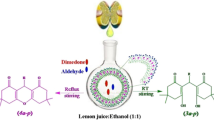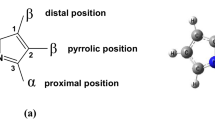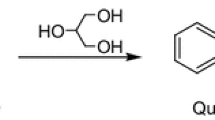Summary
Attempts to determine the orientation of the chlorine atoms in some of the commercial chlorinated indanthrones and in the dichloroindanthrones prepared by the action of antimony pentachloride and sulphuryl chloride on indanthrone and by the action of hydrochloric acid on anthraquinoneazine are described. The higher reactivity of the chlorine atoms in the direct chlorinated indanthrones suggests α-orientation. The dichloro-indanthrone (IIA) from antimony pentachloride is distinguished from the other chloroindanthrones obtained by direct chlorination by its greater resistance to azine formation on treatment with oxidising agents. The 4∶4′-orientation is, therefore, suggested for the chlorine atoms in (IIA), and substitution in the 5, 8, 5′, 8′ positions in the other direct chlorinated indanthrones. Antimony pentachloride was found to be specific in introducing two chlorine atoms in indanthrone. 4∶4′-Di-p-toluenesulphonamido-indanthrone (LV) has been synthesised.
2∶4-Dichloro-1-aminoanthraquinone has been prepared by an improved method and its utility as a dyestuff intermediate has been studied. A few other halogenated aminoanthraquinones and their acyl dervatives which do not appear to have been described in literature have been synthesised.
Similar content being viewed by others
References
Fraser-ThomsonJ. Soc. Dyers Col., 1936,52, 240.
RoweColour Index, 1924.
RoweThe Development of the Chemistry of Commercial Synthetic Dyes (1856–1938),76, 85.
Fraser-ThomsonThorpe’s Dict. App. Chem., 4th Ed., I, 414.
Fraser-ThomsonB.I.O.S. Final Rep., 987, 11.
Fraser-Thomson U.S.P., 2,205,418; 2,413,483; 2,413,514.
Scholl and BerblingerBer., 1903,36, 3434. School and Berblinger and MansfieldIbid. Ber., 1907,40, 322.
Atack and SoutarJ. Soc. Chem. Ind., 1922,41, 170 A; B.P. 134,166;F.P. 774,702.
Ullmann and JunghansAnnalen, 1913,399, 316.
HoubenDas Anthracen und die Anthrachinone, Georg Thieme, Leipzig, 1929.
FyfeApp. Chem. Rep., 1922,7, 88; B.P. 173,166.
Fyfe D.R.P., 199,758.
Fyfe U.S.P., 2,126,456.
Fries and HartmannBer., 1921,54 B, 193.
Guhelmannet al. Ind. Eng. Chem., 1929,21, 1231.
Bedekar and VenkataramanIndian Pat. 34211.
Ullmann and EiserBer., 1916,49, 2156.
Ullmann and Eiser D.R.P. 193,121.
SteinerMonatsh, 1915,36, 825.
Bradley and Derrett-SmithJ. Soc. Dyers Col., 1940,56, 97.
Derrett-Smith and Gee “Recent Advances in the Theory and Practice of Dyeing,”Soc. Dyers Col. Symposium, 1947, 37.
Scholl and EdlbacherBer., 1911,44, 1727.
Author information
Authors and Affiliations
Rights and permissions
About this article
Cite this article
Bedekar, S.G., Tilak, B.D. & Venkataraman, K. Anthraquinone series. Proc. Indian Acad. Sci. (Math. Sci.) 28, 236 (1948). https://doi.org/10.1007/BF03171087
Received:
DOI: https://doi.org/10.1007/BF03171087




